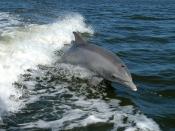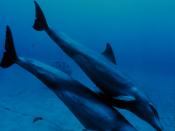Dolphins are mammals closely related to whales
and porpoises. Dolphins have a powerful and streamlined
body. They are found in all seas and oceans. Dolphins can be
told apart from porpoises by their nose, which is beaklike, and
also their conical teeth. Porpoises have a flatter nose, sharper
teeth, and a more solid body.
There are 32 known species of dolphins. The bottle-
nosed dolphin is often the species used in aquatic shows. The
common dolphin inspired many Mediterranean folk lores. Both
of the dolphins above appear in open waters, usually around
cruise ships. They like to show off around the boat.
There are also freshwater dolphins that live in rivers
of Asia and South America. The Buffeo dolphin has been
spotted up to 1250 miles up he Amazon River. The buffeo is the
smallest of all dolphins averaging about 4 feet. The bottlenose
is closer to 10 feet.
The killer whale, which is also considered a
dolphin, can grow to be 30 feet long. The pilot whale is also
considered a dolphin.
Dolphins were once hunted by commercial boats
for the small amount of oil that can be extracted from their
body. This oil is used to lubricate small parts in watches.
Cheaper oils have been found, so dolphins are not hunted for
this reason anymore. Dolphins can be caught in tuna nets by
accident. Since dolphins have to breath at the surface they
drown in tuna nets. It is estimated that 4.8 million dolphins were
killed in tuna nets from 1959 to 1972. Under pressure from
animal rights activists tuna consumers will not accept tuna from
canners that do not protect dolphins. Animal rights activists
also believe that dolphins shouldn't be in captivity for use in
aquatic shows.
Dolphins eat a lot of food in a day,


